Pedagogical Practices That Integrate Learning Management Systems (LMSs)
This paper covers several practices currently developed by college teachers who use Learning Management Systems (LMSs) as part of a hybrid (online and in-class) teaching framework.
These teachers adapted and have perfected valuable practices which make their task easier for them, while fostering motivation, success and learning in students. However, a change is always easier to make when supported by appropriate research. The very purpose of this paper is to make the potential that exists in LMSs known to teachers.
The starting question is the following: What uses of Learning Management Systems (LMSs) should be encouraged, in order to harness their full pedagogical potential in a hybrid teaching context, at the college level?
Table of Contents
The Issue
First, we will explain Learning Management Systems (LMS). Subsequently, we will address some factors in Quebec’s college community, i.e. Generation C, the motivation to learn, and changes in pedagogy.
Digital Learning Environments
Learning Management Systems (LMS) have been a subject of some interest in the fields of college and university education, particularly since the beginning of the 21st century. These Web-accessible environments link the presentation of content to a set of communication and interaction tools. First developed for online training programs, their applications piqued curiosity about their use for teaching purposes. The option of including online activities for completion in class, as well as at home, allowed classrooms to expand, and a new type of instruction to be defined: hybrid teaching (in-class and online). A research group in Louvain suggested a definition of this new teaching reality.
In line with the definition of hybrid mechanisms proposed by Charlier, Deschryver and Peraya (2006), the mechanisms we consider here are supported by a technological platform (a set of tools), and their hybrid nature is the result of the modification of their components (resources, strategies, methods, stakeholders and ultimate purposes) by a recombination of the times and places where teaching and learning occur: it is clearly a question of a continuum. One of its dimensions is linked to the presence-distance relationship and the other to the teaching-learning relationship.
(Docq et al., 2010, p. 49)
Several platforms are available within the college network. Among others, these include the LÉA environment, made by Skytech, combined with the Omnivox platform. It offers several simple communication tools (the ability to send communiqués, an internal messaging system), collaborative tools (forums), class management (student absence and grade logging, calendar sharing for events) and document management (assignment and homework submission).
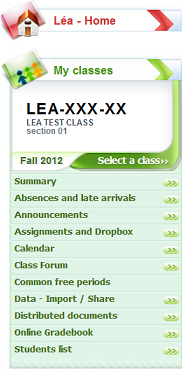
The LÉA platform’s functions – Teacher display
There is also the Moodle LMS platform, as popular in colleges as it is in university settings, which allows content to be organized into learning sequences when adding content (web pages, documents, glossaries), collaborative tools (forums, wikis) and learning activities (questionnaires, lessons) in a desired order. The platform also provides communication tools (chat, email).
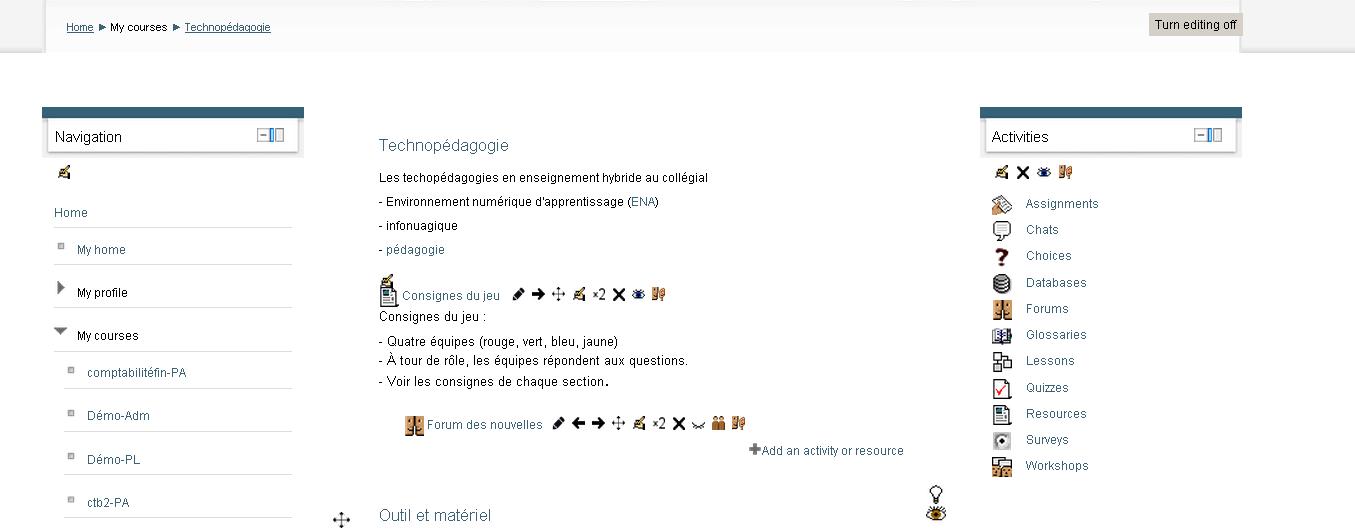
The Moodle LMS Digital Learning Environment – Splash theme
DECclic offers several different resources available online at the following address: http://portail.moodle.decclic.qc.ca/index.php?lang=en_utf8
Some universities use the WebCT platform, although several have decided to begin a migration to other platforms. Some have also chosen to develop their own platform, such as the one described in the Université Laval’s LMSs in Four Minutes video (http://www.ena.ulaval.ca/4_minutes/player.html).
Generation C
Young adults born between 1984 and 1996 were the subject of a CEFRIO study in 2008-09. They are representative of the current and future clientele at the college level. The purpose of the research was to assess the validity of a an exciting hypothesis, according to which the massive use of information and communication technologies (ICT) by many young adults has a marked impact on how they perceive, and behave in, the world (CEFRIO, 2008, p. 3).
More than 85% of the surveyed young adults between 12 and 24 have already done research on the Internet and have communicated via email, while more than 70% of them have downloaded or listened to music online, according to the study. In part, these results confirm the hypothesis that young adults are skilled with computers. They have been called Generation C, in reference to three specific areas that typify them: communication, collaboration and creativity. Their culture has revolved around computers since their earliest childhood. This medium is so natural to them that a world without computers is practically inconceivable to their minds. It has been observed that young adults are better-organized, and submit better-quality assignments with the help of ICT.
The Motivation to Learn
One other factor encouraging teachers to integrate ICT is the fact that such mechanisms increase the student’s motivation to learn. Viau dedicated an entire chapter to the impact of ICT in his book titled La motivation à apprendre en milieu scolaire (The Motivation to Learn in the School Setting). He describes his thinking as follows :
Teachers must integrate ICT into their classrooms, but under certain conditions. In fact, as with the five factors [in Chapter 5], if we want ICT to have a positive influence on students’ motivational dynamics, [ICT] must meet motivational requirements.
(Viau, 2009, p. 173)
But what about the impact of not using ICT in the classroom? Viau clearly answers this question :
It is difficult to imagine that the school setting would become an isolated island where ICT would be used sparingly, and only for administrative and management purposes. Do not forget that working with computers and surfing the internet is already a part of daily routine for elementary and secondary school students. Karsenti (2003, p. 31) justly emphasizes that the absence of ICT in schools may have a negative impact on student motivation, and more specifically, on boys’ motivation, because there would be too great a division between the presence of ICT in society, and the presence of ICT in schools.
(Viau, 2009, p. 174)
Changes to Pedagogy
Viau explains that the changes brought about by ICT are having an influence on the teacher’s role.
ICT are tools which must be, and can be, used as part of pedagogical activities. ICT have features which confer “motivational potential”, on the condition, certainly, that such potential is properly harnessed for pedagogical activities. Implementation of ICT in a class requires the teacher to reconsider their role. They must resign themselves to making significant room for ICT as sources of information, and take on the task of facilitating, guiding and supporting students in the acquisition of new competencies, such as those used to find and process information.
(Viau, 2009, p. 181)
Barrette’s meta-synthesis (2009) puts forward a solution and proposes pedagogical changes which teachers would have to make in order to effectively integrate LMSs into their teaching activities.
The implementation of socioconstructivist mechanisms requires changes in practice by professors, and these changes are also very susceptible to the organizational requirements of each institution.
(Barrette, 2009, p. 20)
Practical Applications
First, a general observation must be made: Not all students are comfortable with LMSs. Because of this, it is preferable that the teacher demonstrate the proposed tool for students.
In addition, the teacher must encourage the student to form the habit of checking the platform on a regular basis, to manage their time, and their assignments. If, at the start of the term, the teacher announces that a particular platform will be used as the communication tool for the course, students will have a tendency to refer to it, so as not to miss important information. Checking an LMS only takes a few minutes, and requires only a computer or mobile device with access to the Internet.
Classroom Management
In order to foster good supervision of students, it is suggested that absences be noted on a regular basis (every class, every day or every week) and recorded in the LMS right away (not using paper).
Variant : Some teachers prefer to record attendance on paper in class, and transfer it onto the computer after the class.
At the start of the semester, the teacher must inform students of college regulations and departmental policies governing attendance in class. Throughout the semester, messages sent via email or the messaging system would be sent as a warning to students who are close to reaching the maximum number of allowable absences.
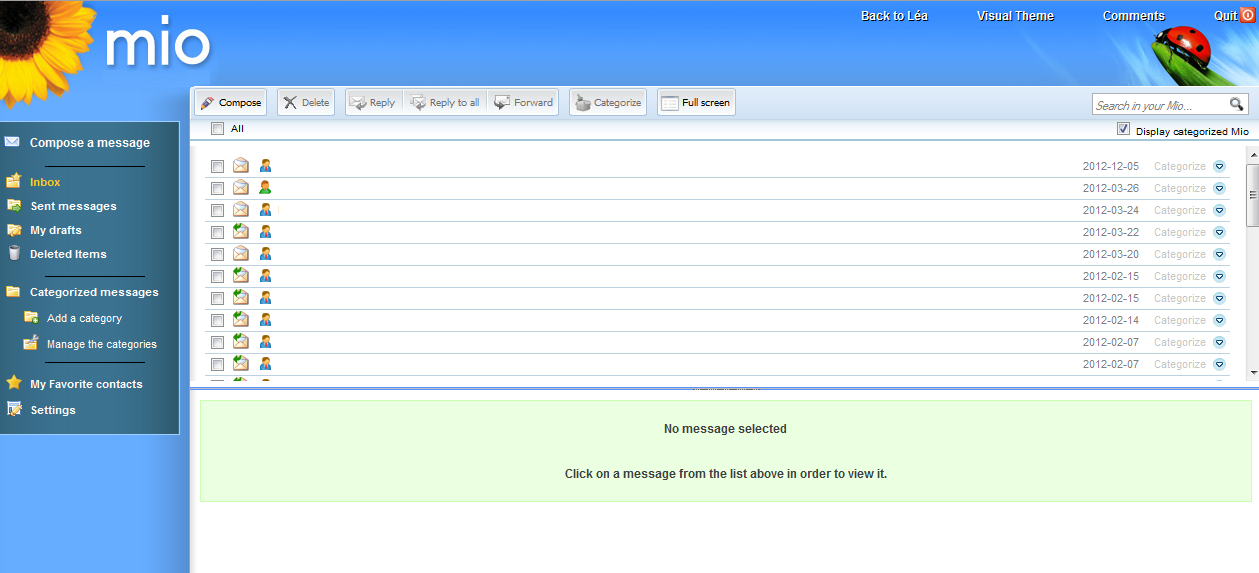
The LÉA platform’s MIO email interface
Impacts on the student
- The student becomes aware of their responsibility, by checking their own absences.
- The tool serves as a reminder to the student.
- The student sees that the teacher is invested in their success.
- Teachers see fewer absences and less tardiness when this practice is applied.
- The tool promotes clear communication between teacher and student: the record would be quickly corrected in cases of error or misunderstanding (for example, tardiness rather than absence). This procedure prepares the student for the labour market.
Impacts on the teacher
The record of absences offers additional information when making decisions about grade reviews. The teacher saves time in class, because students no longer ask how many times they’ve been absent. The tool allows quicker, stricter monitoring of absentee students and avoids academic disputes.
How can a list of students help teachers’ relationships with students?
A list of students, by name and by course, makes it possible for the teacher to create personalized sublists by adding various kinds of information about the students.
Teachers can consult these lists to learn their students’ names (using their photos, for example) before meeting them. This list may also be useful to exam supervisors for the purposes of exercising better control, if they do not know the group.
In a paper format, the list facilitates noting information such as the submission of homework and random drawings for team creation. For purposes of participation, lists can be personalized as needed (addition of columns, sorting of desired information, etc.).
Impacts on the student
The fact that the teacher knows the names of their students fosters a relationship between them.
Impacts on the teacher
Monitoring students allows teachers to justify a decision in the case of grade review or academic dispute.
Managing Activity Planning
Many students use electronic organizers for recreation or work. Why not also use this tool for school? Learning Management Systems generally provide a calendar to which teachers can add events.
Below is a list of events which will help students to plan their studies :
- Exams
- Required readings
- Meetings
- Field trips
- Speakers
- Special events (open houses, orientation days, etc.)
- Reminders about supplies and classrooms
- Labs
- Submission of assignments and homework
Students can be asked to submit homework and assignments using quick and easy online methods. When they are in practicum or work term placements or simply away from the college, students have the option to post their assignments to the LMS remotely. Online submission of assignments is even more useful in special circumstances such as strikes, storms or illnesses. It is pedagogically effective to return a corrected copy to the student before the next class, especially in cases of prolonged absence (reading week, practicum/internship/work term, or co-op term, etc.). Additonally, using LMSs, students are able to post different types of assignments, such as lab reports, practicum journals, research assignments, etc.
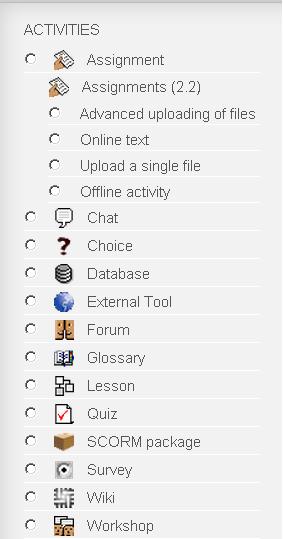
Activities offered via the Moodle LMS platform
Online correction of assignments allows teachers to add more comments than otherwise might be made on a paper copy and gives the teacher the option of returning documents by online methods. Another option is for the teacher to record audio summaries of their corrections and return them to the student in the same way. It is easier for the student to listen to comments rather than to have to read hand-written comments on hard copy. They can view their corrected assignment without having to print it out or go anywhere to get it, which helps the student develop their environmental awareness, and their understanding of the concept of cloud computing.
Required file formats can also be varied (text, sound or video). Care must be taken however, to monitor the size of files being submitted, as many systems have limits. If a teacher has several files they would like to return to a student simultaneously (for example, a marking sheet and the student’s work), generally, within an LMS, the files can be compressed into one folder, for a single post to the system.
Impacts on the student
Generally, an LMS gives the student the option of checking their original and their corrected work as two separate files. Both the student’s and teacher’s school bags are much lighter, as a result!
Impacts on the teacher
The teacher keeps an electronic copy for later consultation or in case of academic dispute. Monitoring is possible thanks to the calendar, where the date is recorded when the student hands in an assignment.
Communication
Communication between teachers and students is of paramount importance for academic success. Over the years, methods of communication have changed greatly. The majority of young adults have a cell phone which they use to send text messages, rather than talk on the phone. Teaching has also had to adapt to email, messaging systems and forums.
These methods of communication make it possible to send messages or reminders to students. Used in moderation, they make communication more official. The teacher sends messages to advise students of further information added to the course, to provide educational support, to check to see how often students consult the platform, etc. Below are a few more examples of potential uses :
- Announcing an exam date, assignment deadline or event
- Sending an internet link, a list of supplies to bring or to buy
- Advising students of teacher absences, or changes and additions to course information, etc.
In this context, it is a good idea to establish some netiquette rules and make sure that they are followed. It is recommended that students be given few instructions in this regard: if too many are imposed, they will not respect the rules. Below are a few examples of easy-to-follow instructions.
Netiquette:
- Avoid the upper case which gives the impression of YELLING
- Before typing a question, check to see if it has already been asked
- Write using respectful, non-judgmental language
- If an author is cited, indicate the source and the author, and respect copyright
- Use correct English when writing
As these tools are asynchronous (time-delayed communication), periods of availability are not specified, as with office hours or classes. The teacher must not say that they are available 7 days a week, 24 hours a day. Here is an example of a boundary announced to students : I will respond to your message in 24 to 48 hours, from Monday to Friday, between 9 a.m. and 3 p.m, but not on weekends. For more complex questions, I suggest making an appointment to see me, rather than using messaging systems.
Messaging systems are easy to use, and students check them frequently. They also use such systems to send questions to their teachers or advise them of absences. Photographs which can be attached to messages enable the teacher to recognize the student immediately. This tool is very practical for an individual who teaches on a part-time basis or who is teaching a course where an extended period of time passes, between classroom meetings. Messaging in an LMS allows for messages to be sent to a student, to a subgroup, or to an entire group. Some teachers even use it to communicate with colleagues, instead of using the college’s email service. Otherwise, email is very popular in education, whether via LMS or used through another service provider. Email serves the same purpose as other messaging systems.
The forum is another channel for communication between students and the teacher, and for students among themselves. It meets a pedagogical need oriented towards learning and collaboration, and can be used by a group, a team, or a single individual. Below are a few simple rules to encourage success in forums :
- Establish a set amount of time for an exchange. The amount of time spent should be set according to type of activity being done.
- Sustain activities by asking questions and adding comments regularly. A lively forum attracts readers and prompts young adults to write questions and comments.
- Encourage students to read previous topics before sending their questions. This will prevent the redundancy of similar questions.
For more examples, and specific instructions about each of these examples, please see the Wikipedia article on Etiquette (technology).
Impacts on the student
LMS tools make teacher-student communications more official and prevent such messages from getting lost among a student’s personal messages. In this way, the student learns to separate their personal life from their schoolwork, preparing them for the workplace. In the case of the forum, comments and questions are read by their peers: social pressure prompts students to write original and pertinent comments.
Impacts on the teacher
Discussions are archived and may be reread later. Messages are easy to find in an LMS, because they are saved. This provides valuable evidence in cases of academic dispute.
Adverse effects
Communication tools may have an adverse effect on the student’s independence and organization. Some relatively shy students, rather than develop their ability to communicate, will use these tools to avoid the teacher. Others will have a tendency to ask for an answer from the teacher too quickly and easily, rather than seeking a solution themselves. Students might also choose the easy way out, and send several messages, one after the other. The teacher should then redefine the situation and request that the student meet them in their office.
Resources
Posting documents via LMS makes course files available at any time, anywhere. The student benefits from direct access and avoids the physical constraints of traditional tools (books, libraries, lecture notes on paper). The student can consult, download or print the files at whatever time they need to.
Below are examples of documents posted by teachers :
- Course plans
- Study guides
- Schedules
- Reference documents
- Exercises
- Lists of websites
- Formative tests and solutions
- Various illustrations
- Multimedia files
- Various documents (policies, [from] professional associations, PowerPoint presentations)
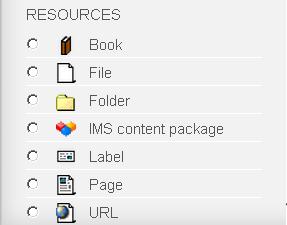
Resources offered through the Moodle LMS platform
In order to maintain page layout and prevent students from changing a document, PDF format is recommended. If internet links are worth sharing, or the student needs to write in the document, a word processing format such as Word is preferable. Remember that particular attention needs to be paid to file size, as it relates to maximum system capacity, as well as to the maximum number of files posted, per course.
Impacts on the student
The posting of documents encourages students to check the LMS and to develop some independence with respect to the different pedagogical activities being proposed (time and assignment management). Documents can be made available for the following semesters, which is a great advantage especially for review courses and for courses with pre-requisites. Students like working that way.
Adverse effects
Because students are able to consult documents with their smartphones during an exam, special monitoring is required. Document access statistics provide evidence of such consultation. If the teacher explains this fact before the exam, it will have a deterrent effect on students – better to warn than punish.
Suggestion
During the first class, the teacher can warn students to not consult documents during an exam, describe the tools at their disposal to check for such consultation (document access statistics) and specify the penalty in case of a breach of the rules. Warnings often have a deterrent effect.
Impacts on the teacher
The teacher who provides students with a list of recommended websites makes the student aware of the different types of resources accessible on the internet. Students need to be guided through the vast virtual world that is the Web. They need to learn how to judge whether a site is valid, or not. Internet research is anchored in youth culture, but they need concrete examples and criteria for assessing the usefulness of websites.
Below are a few examples of useful websites :
- List of community organizations and service providers
- Promotional videos
- Online course manuals
- Activity/discussion sites, or sites related to the course
- Online tutorials
- Websites created for course purposes
- Websites related to the job market
- Websites described in the course plan’s mediagraphy
- Web TV broadcasts
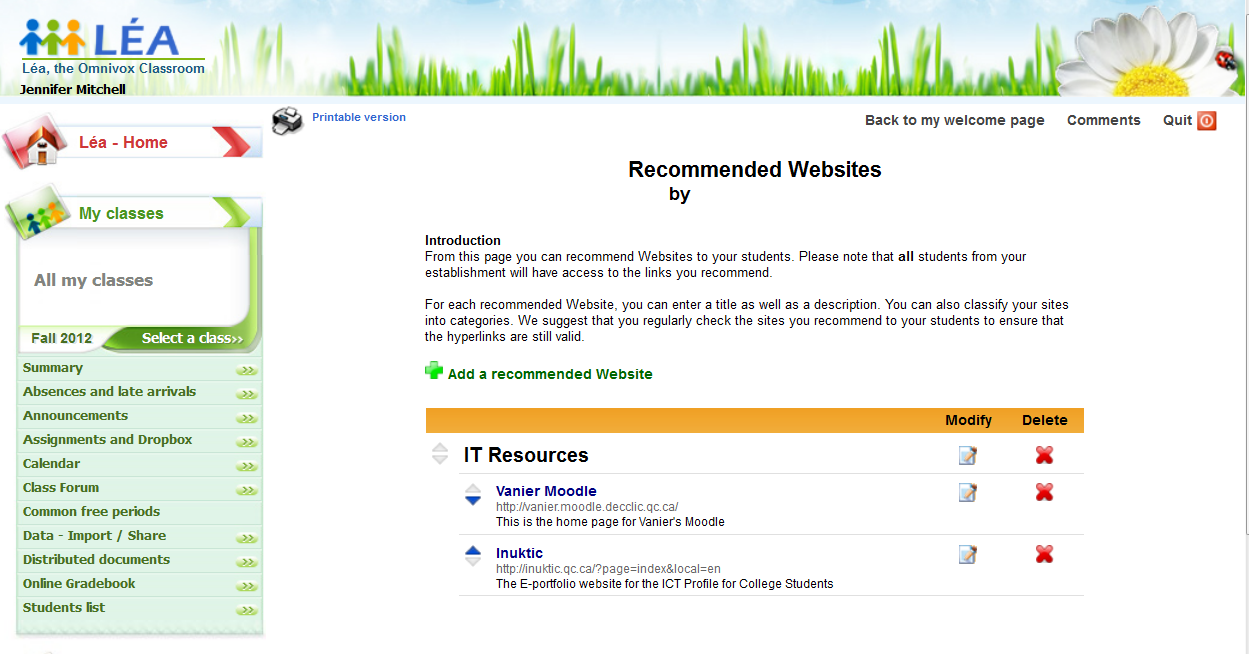
LÉA’s “Recommended Website” function – Teacher display
Conclusion
Digital learning environments were first used for distance education, but now they are also used as part of regular teaching activities, with the emergence of what is now called hybrid teaching. It remains to be seen how these environments will evolve.
Young adults adore social media and online access to different resources. Online games are also highly thought of, and tablet computers are starting to invade our institutions. LMSs are adapting to these realities, but there is still work to be done.
In the college environment, we are starting to talk about metacourses, i.e. survey courses linked to one or more specialized courses. This type of course can be linked to a set of resources that the student may access for the entire duration of their studies.
And although a platform that will follow the student from college into university may be wishful thinking, we can still dream!
Useful References
- Barrette’s meta-synthesis (2009) puts forward a solution and proposes pedagogical changes which teachers could make in order to effectively integrate digital learning environments into their teaching activities. BARRETTE, C. (2009). « Métarecherche sur les effets de l’intégration des TIC en pédagogie collégiale », Revue internationale des technologies en pédagogie universitaire, 6(2-3), p. 18-25.
- Young adults born between 1984 and 1996 were the subject of a CEFRIO study in 2008-09. They represent current and future clientele at the college level. Results confirm the hypothesis that young adults are skilled with computers. They have been called Generation C, in reference to communication, collaboration and creativity.
CEFRIO (2009). Génération C, les 12-24 ans – Moteurs de transformation des organisations. - The following article describes several pedagogical strategies which make good use of the forum, the communication tool available within LMSs that encourages exchanges between students and teachers.
DESROSIERS, C. (2011). « Vous dites forum? », CLIC, Number 77, October 2011. Consulted on November 1, 2011. - Rabardel (1995) and the ACOT group (Dwyer, 1995) began a study at the Université de Louvain (Docq et al., 2010) which enabled the elaboration of a model in accordance with categories and criteria for hybrid teaching using an LMS, which enriched course objectives.
DOCQS, F., M. LEBRUN, et D. SMIDTS (2010). « Analyse des effets de l’enseignement hybride à l’université : détermination de critères et d’indicateurs de valeurs ajoutées », Revue internationale des technologies en pédagogie universitaire, 7(3), p. 48-59. - VIAU, R. (2009). La motivation à apprendre en milieu scolaire, Saint-Laurent, Éditions du renouveau pédagogique, 215 p. Finally, Viau underlines the existence of two types of condition to be met to encourage motivation in students; conditions that, above all, are pedagogical in nature (Chapter 5), and conditions specific to ICT (Chapter 6).

